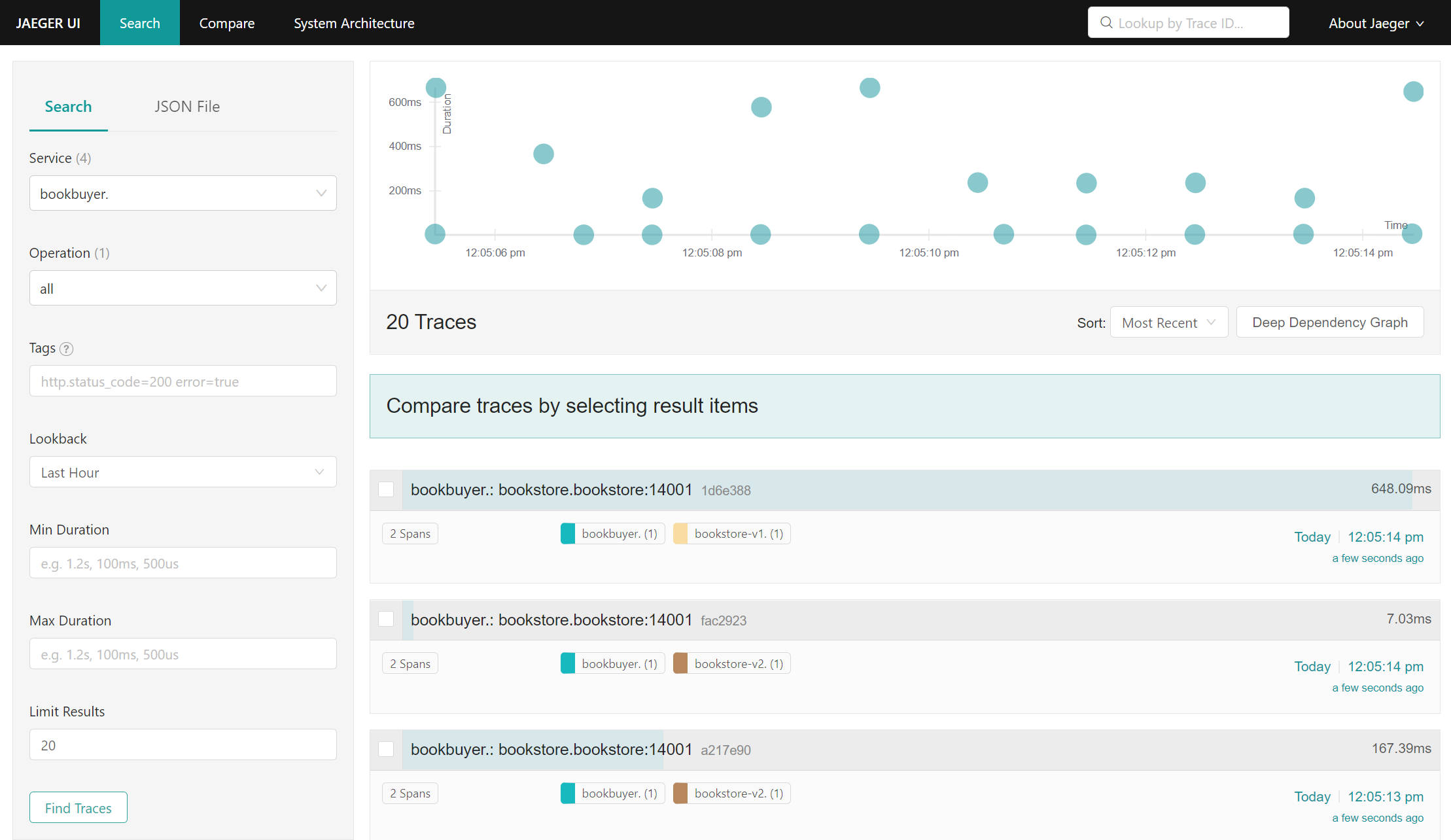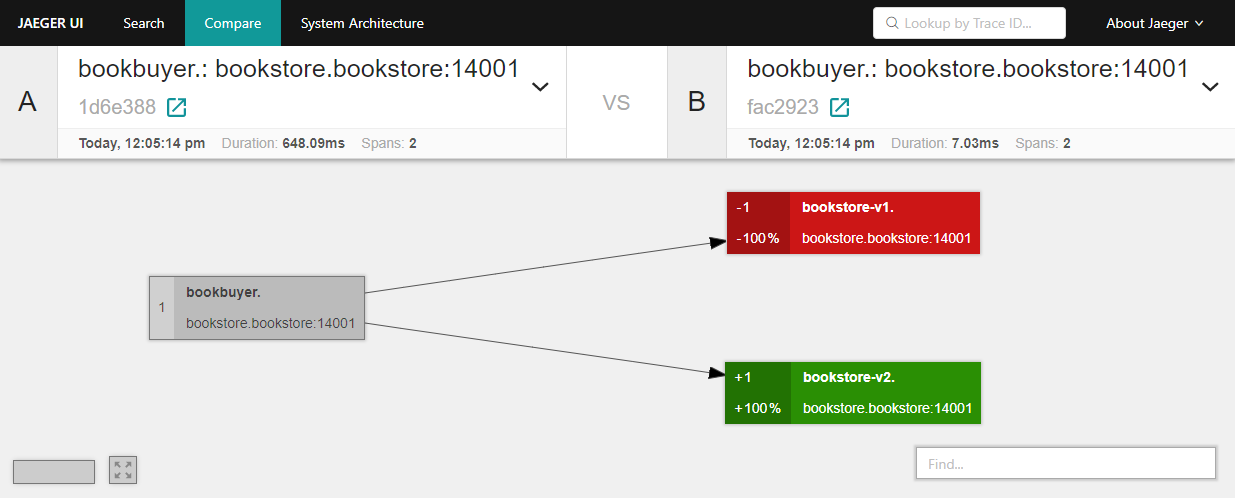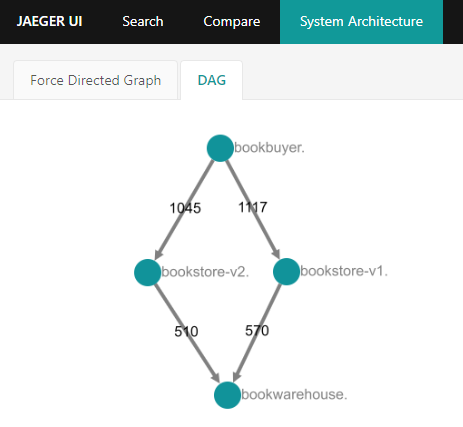Tracing
Open Service Mesh (OSM) allows optional deployment of Jaeger for tracing. Similarly, tracing can be enabled and customized during installation (tracing section in values.yaml) or at runtime by editing the osm-mesh-config custom resource. Tracing can be enabled, disabled and configured at any time to support BYO scenarios.
When OSM is deployed with tracing enabled, the OSM control plane will use the user-provided tracing information to direct the Envoys to send traces when and where appropriate. If tracing is enabled without user-provided values, it will use the defaults in values.yaml. The tracing-address value tells all Envoys injected by OSM the FQDN to send tracing information to.
OSM supports tracing with applications that use Zipkin protocol.
Jaeger
Jaeger is an open source distributed tracing system used for monitoring and troubleshooting distributed systems. It allows you to get fine-grained metrics and distributed tracing information across your setup so that you can observe which microservices are communicating, where requests are going, and how long they are taking. You can use it to inspect for specific requests and responses to see how and when they happen.
When tracing is enabled, Jaeger is capable of receiving spans from Envoys in the mesh that can then be viewed and queried on Jaeger’s UI via port-forwarding.
OSM CLI offers the capability to deploy a Jaeger instance with OSM’s installation, but bringing your own managed Jaeger and configuring OSM’s tracing to point to it later is also supported.
Automatically Provision Jaeger
By default, Jaeger deployment and tracing as a whole is disabled.
A Jaeger instance can be automatically deployed by using the --set=OpenServiceMesh.deployJaeger=true OSM CLI flag at install time. This will provision a Jaeger pod in the mesh namespace.
Additionally, OSM has to be instructed to enable tracing on the proxies; this is done via the tracing section on the MeshConfig.
The following command will both deploy Jaeger and configure the tracing parameters according to the address of the newly deployed instance of Jaeger during OSM installation:
osm install --set=OpenServiceMesh.deployJaeger=true,OpenServiceMesh.tracing.enable=true
This default bring-up uses the All-in-one Jaeger executable that launches the Jaeger UI, collector, query, and agent.
BYO (Bring-your-own)
This section documents the additional steps needed to allow an already running instance of Jaeger to integrate with your OSM control plane.
NOTE: This guide outlines steps specifically for Jaeger but you may use your own tracing application instance with applicable values. OSM supports tracing with applications that use Zipkin protocol
Prerequisites
- A running Jaeger instance
- Getting started with Jaeger includes a sample app as a demo
Tracing Values
The sections below outline how to make required updates depending on whether you already already have OSM installed or are deploying tracing and Jaeger during OSM installation. In either case, the following tracing values in values.yaml are being updated to point to your Jaeger instance:
enable: set totrueto tell the Envoy connection manager to send tracing data to a specific address (cluster)address: set to the destination cluster of your Jaeger instanceport: set to the destination port for the listener that you intend to useendpoint: set to the destination’s API or collector endpoint where the spans will be sent to
a) Enable tracing after OSM control plane has already been installed
If you already have OSM running, tracing values must be updated in the OSM MeshConfig using:
# Tracing configuration with sample values
kubectl patch meshconfig osm-mesh-config -n osm-system -p '{"spec":{"observability":{"tracing":{"enable":true,"address": "jaeger.osm-system.svc.cluster.local","port":9411,"endpoint":"/api/v2/spans"}}}}' --type=merge
You can verify these changes have been deployed by inspecting the osm-mesh-config resource:
kubectl get meshconfig osm-mesh-config -n osm-system -o jsonpath='{.spec.observability.tracing}{"\n"}'
b) Enable tracing at OSM control plane install time
To deploy your own instance of Jaeger during OSM installation, you can use the --set flag as shown below to update the values:
osm install --set OpenServiceMesh.tracing.enable=true,OpenServiceMesh.tracing.address=<tracing server hostname>,OpenServiceMesh.tracing.port=<tracing server port>,OpenServiceMesh.tracing.endpoint=<tracing server endpoint>
View the Jaeger UI with Port-Forwarding
Jaeger’s UI is running on port 16686. To view the web UI, you can use kubectl port-forward:
OSM_POD=$(kubectl get pods -n "$K8S_NAMESPACE" --no-headers --selector app=jaeger | awk 'NR==1{print $1}')
kubectl port-forward -n "$K8S_NAMESPACE" "$OSM_POD" 16686:16686
Navigate to http://localhost:16686/ in a web browser to view the UI.
Example of Tracing with Jaeger
This section walks through the process of creating a simple Jaeger instance and enabling tracing with Jaeger in OSM.
-
Run the OSM Demo with Jaeger deployed. You have two options:
-
For automatic provisioning of Jaeger, simply set
DEPLOY_JAEGERin your.envfile to true -
For bring-your-own, you can deploy the sample instance provided by Jaeger using the commands below. If you wish to bring up Jaeger in a different namespace, make sure to update it below.
Create the Jaeger service.
kubectl apply -f - <<EOF --- kind: Service apiVersion: v1 metadata: name: jaeger namespace: osm-system labels: app: jaeger spec: selector: app: jaeger ports: - protocol: TCP # Service port and target port are the same port: 9411 type: ClusterIP EOFCreate the Jaeger deployment.
kubectl apply -f - <<EOF --- apiVersion: apps/v1 kind: Deployment metadata: name: jaeger namespace: osm-system labels: app: jaeger spec: replicas: 1 selector: matchLabels: app: jaeger template: metadata: labels: app: jaeger spec: containers: - name: jaeger image: jaegertracing/all-in-one args: - --collector.zipkin.host-port=9411 imagePullPolicy: IfNotPresent ports: - containerPort: 9411 resources: limits: cpu: 500m memory: 512M requests: cpu: 100m memory: 256M EOF
-
-
Enable tracing and pass in applicable values. If you have installed Jaeger in a different namespace, replace
osm-systembelow.kubectl patch meshconfig osm-mesh-config -n osm-system -p '{"spec":{"observability":{"tracing":{"enable":true,"address": "jaeger.osm-system.svc.cluster.local","port":9411,"endpoint":"/api/v2/spans"}}}}' --type=merge -
Refer to instructions above to view the web UI using port forwarding
-
In the browser, you should see a
Servicedropdown which allows you to select from the various applications deployed by the bookstore demo.a) Select a service to view all spans from it. For example, if you select
bookbuyerwith aLookbackof one hour, you can see its interactions withbookstore-v1andbookstore-v2sorted by time.
Jaeger UI search for bookbuyer traces
b) Click on any item to view it in further detail
c) Select multiple items to compare traces. For example, you can compare the
bookbuyer's interactions withbookstore-v1andbookstore-v2at a particular moment in time:
bookbuyer interactions with bookstore-v1 and bookestore-v2
d) Click on the
System Architecturetab to view a graph of how the various applications have been interacting/communicating. This provides an idea of how traffic is flowing between the applications.
Directed acyclic graph of bookstore demo application interactions
If you are not seeing the bookstore demo applications in the Jaeger UI, tail the bookbuyer logs to ensure that the applications are successfully interacting.
POD="$(kubectl get pods -n "$BOOKBUYER_NAMESPACE" --show-labels --selector app=bookbuyer --no-headers | grep -v 'Terminating' | awk '{print $1}' | head -n1)"
kubectl logs "${POD}" -n "$BOOKBUYER_NAMESPACE" -c bookbuyer --tail=100 -f
Expect to see:
"MAESTRO! THIS TEST SUCCEEDED!"
This suggests that the issue is not caused by your Jaeger or tracing configuration.
Troubleshoot Tracing/Jaeger
When tracing is not working as expected.
1. Verify that tracing is enabled
Ensure the enable key in the tracing configuration is set to true:
kubectl get meshconfig osm-mesh-config -n osm-system -o jsonpath='{.spec.observability.tracing.enable}{"\n"}'
true
2. Verify the tracing values being set are as expected
If tracing is enabled, you can verify the specific address, port and endpoint being used for tracing in the osm-mesh-config resource:
kubectl get meshconfig osm-mesh-config -n osm-system -o jsonpath='{.spec.observability.tracing}{"\n"}'
To verify that the Envoys point to the FQDN you intend to use, check the value for the address key.
3. Verify the tracing values being used are as expected
To dig one level deeper, you may also check whether the values set by the MeshConfig are being correctly used. Use the command below to get the config dump of the pod in question and save the output in a file.
osm proxy get config_dump -n <pod-namespace> <pod-name> > <file-name>
Open the file in your favorite text editor and search for envoy-tracing-cluster. You should be able to see the tracing values in use. Example output for the bookbuyer pod:
"name": "envoy-tracing-cluster",
"type": "LOGICAL_DNS",
"connect_timeout": "1s",
"alt_stat_name": "envoy-tracing-cluster",
"load_assignment": {
"cluster_name": "envoy-tracing-cluster",
"endpoints": [
{
"lb_endpoints": [
{
"endpoint": {
"address": {
"socket_address": {
"address": "jaeger.osm-system.svc.cluster.local",
"port_value": 9411
[...]
4. Verify that the OSM Controller was installed with Jaeger automatically deployed [optional]
If you used automatic bring-up, you can additionally check for the Jaeger service and Jaeger deployment:
# Assuming OSM is installed in the osm-system namespace:
kubectl get services -n osm-system -l app=jaeger
NAME TYPE CLUSTER-IP EXTERNAL-IP PORT(S) AGE
jaeger ClusterIP 10.99.2.87 <none> 9411/TCP 27m
# Assuming OSM is installed in the osm-system namespace:
kubectl get deployments -n osm-system -l app=jaeger
NAME READY UP-TO-DATE AVAILABLE AGE
jaeger 1/1 1 1 27m
5. Verify Jaeger pod readiness, responsiveness and health
Check if the Jaeger pod is running in the namespace you have deployed it in:
The commands below are specific to OSM’s automatic deployment of Jaeger; substitute namespace and label values for your own tracing instance as applicable:
kubectl get pods -n osm-system -l app=jaeger
NAME READY STATUS RESTARTS AGE
jaeger-8ddcc47d9-q7tgg 1/1 Running 5 27m
To get information about the Jaeger instance, use kubectl describe pod and check the Events in the output.
kubectl describe pod -n osm-system -l app=jaeger
External Resources
Feedback
Was this page helpful?
Glad to hear it! Please tell us how we can improve.
Sorry to hear that. Please tell us how we can improve.